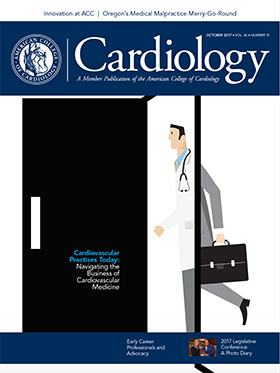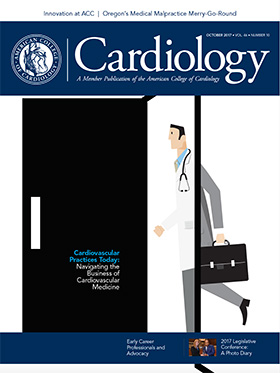Heart of Health Policy | Oregon's Medical Malpractice Merry-Go-Round: How Did We Get Here?

For an event to legally justify medical malpractice, it must exhibit three components: 1) a violation of the standard of care; 2) injury caused by negligence; and 3) injury resulting in significant economic and non-economic damages. Economic damages are readily definable, for example, loss of income, medical costs or the cost of rehabilitation. Non-economic damages are more subjective and, at times, ambiguous, such as pain and mental suffering, emotional distress, loss of care, comfort and companionship, among others.
Throughout the 1970s and 1980s, the number of filed malpractice claims and the amounts of resulting awards increased. In the year 2000, medical malpractice awards rose by 400 percent, and in 2001, the insurance industry took a pre-tax loss of $258 million. Some insurance companies failed, while others stopped providing malpractice policies or left the market entirely, causing premiums to rise at an alarmingly rapid pace. Physicians were forced to respond by retiring early, self-insuring or relocating to regions in which manageable medical malpractice insurance was more readily available.
Oregon is a largely rural state that continually suffers from shortages of health care providers. These providers are among the most vulnerable, as Oregon’s Medicare and Medicaid rates are among the lowest in the U.S. The Oregon State Constitution, ratified in 1857, includes provisions for the settlement of civil liability claims. Constitutionally, medical malpractice claims fell under these civil liability statutes until 1987. While the escalation in malpractice costs has been caused by many factors, unchecked non-economic damage awards are the most visible.
|
In 1987, Oregon legislators passed tort reform efforts that placed a cap of $500,000 on non-economic damages. As in many other states with caps, this legislation was repeatedly challenged in court. In 1999, the Oregon Supreme Court ruled the cap unconstitutional under a provision that states: “In all civil cases the right of a trial by jury shall remain inviolate.” Meaning the Oregon constitution views non-economic damages as a question of fact that must be decided by a jury. It specifically states that the legislature may not interfere with the full effect of a jury’s assessment of non-economic damages.
In 2004, Measure 35 was submitted as an attempt to restore the $500,000 cap on non-economic damages. The bill was defeated by 17,000 votes, less than 1 percent of votes cast. In 2013, defendants in a medical malpractice litigation sought to enforce the statutory cap. Again, the Oregon Supreme Court ruled the statute to be unconstitutional citing the same clause.
In 2016, the Oregon Supreme Court reversed its previous ruling, finding that, in most instances, legislation can constitutionally impose caps, eliminating a blanket ban. However, it stipulated that if the cap is insubstantial in comparison with the award decided upon by the jury, the cap no longer applies. For example, if a jury awards $12 million as compensation for non-economic damages, the $500,000 cap does not apply because it represents a “paltry sum,” a term yet to be specifically defined, in comparison to the jury award.
In early 2017, the Oregon Senate introduced S.B. 487, new tort reform legislation to remove the cap on all non-economic damages. S.B. 487 did not have enough support to constitute a vote, but a variation of the legislation shortly resurfaced as S.B. 737, which would limit non-economic damages for wrongful death to $1 million, with no cap on other non-economic damages. Oregon Governor Kate Brown and other proponents of the bill lobbied hard, putting substantial pressure on senators to approve the legislation.
ACC’s Oregon Chapter, with the support of ACC’s grassroots advocacy staff, identified Oregon senators whose voting position on the legislation was undecided. We personally met with these senators, presenting professionally prepared fact sheets that thoughtfully detailed our opposition to the bill and the consequences related to lifting these caps. We also presented a list of additional institutions and societies that shared our views.
In summary, state laws governing medical malpractice suits are dynamic and subject to repeated challenges. Proposed changes are frequently to the disadvantage of the defendant. Monitoring legislative activity is crucial, as is identifying legislators that may be open to discussion. Carefully crafted position statements are necessary to successfully advance our position, and there is no better alternative than to meet face-to-face with lawmakers.
Tweet this article: Tweet
References
- American Board of Professional Liability Attorneys. What Is Malpractice? Available here.
- Hedrick VB. The Medical Malpractice Crisis: Bandaging Oregon’s Wounded System and Protecting Physicians. Williamette Law Review 2007;43(3). Available here.
- National Conference of State Legislatures. Medical Liability and Malpractice. Available here.
- Mangalmurti S, Seabury SA, Chandra A, Lakdawalla D, Oetgen WJ, Jena AB. Medical professional liability risk among US cardiologists. Am Heart J 2014;67:690-6.
- Boehmer ML. Constitutionality of Oregon’s Non-Economic Damages Cap. Available here.
 |
|
| Click the cover image above to read the latest issue of Cardiology in e-pub format or click here to read it on the web! | |
Keywords: ACC Publications, Cardiology Magazine, Liability, Legal, Medicaid, Standard of Care, Stress, Psychological, Malpractice, Compensation and Redress, Insurance Carriers, Medicare, Politics, Health Personnel, Pain, Awards and Prizes
< Back to Listings

